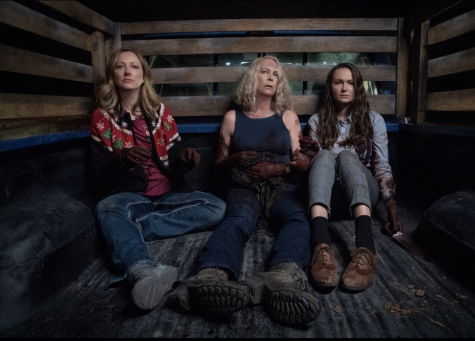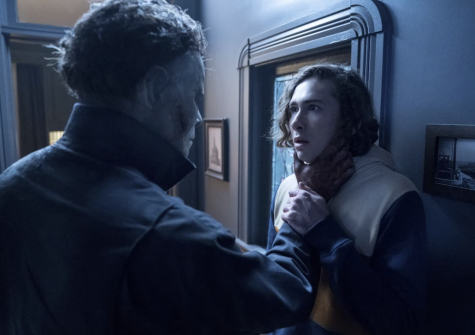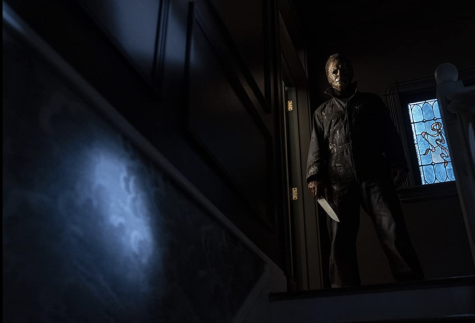REVIEW: Wilmington is the backdrop for grisly murders and nonsensical characters in ‘Halloween Kills’
The long-awaited sequel to 2018’s “Halloween” introduces several story elements to the new canon. “Halloween Kills” is a darker and more violent sequel that further explores the mythology of serial killer Michael Myers and sets the stage for the closing film of the trilogy, titled “Halloween Ends.” Fans may walk into the film with certain expectations, such as a greater focus on main character Laurie Strode or a more direct confrontation between her and Michael; however, the film subverts expectations by giving attention to supporting characters and setting the stage for a grand finale.
Filmed in Wilmington, North Carolina during the fall season in 2019, “Halloween Kills” is the first Wilmington production to receive a theatrical release from a major studio in some time. Although the previous film was shot in Charleston, South Carolina and decorated to be the fictional town of Haddonfield, Illinois, the sequel seamlessly carries over Charleston’s set design while maintaining Wilmington’s distinctiveness. Wilmington locals may recognize some of the town’s locations, such as Cape Fear Community College being decorated into a hospital and the Rusty Nail bar as the venue where the supporting characters are introduced.

Set directly after the 2018 film’s conclusion, series protagonist Laurie (Jamie Lee Curtis) finds herself in critical condition after a heated face-off with Michael Myers. Alongside her daughter Karen (Judy Greer) and granddaughter Allyson (Andi Matichak), Laurie believes that she has defeated Michael and ended the trauma that has haunted her for 40 years. On the contrary, Michael survives the trap set by Laurie and continues his brutal killing spree as he retraces his steps home. Aware of his prison escape, the town citizens, as well as the survivors and witnesses of Michael’s 1978 killing spree, band together under the leadership of Tommy Doyle (Anthony Michael Hall) to put an end to the evil killer once and for all.
The film continues the new continuity established by the sequel and expands the “Michael vs. Laurie” narrative into “Michael vs. Everyone.” After discontinuing the sequels and reboot that followed the 1978 film, the new trilogy acts as a direct continuation that will definitively conclude the franchise, or at least this iteration of it. With the trilogy aspect in mind, “Halloween Kills” can be viewed almost as an interlude to the larger story being told across three films. Laurie isn’t much of a prominent character in this film, as her character is recovering from her wounds, which leads to more focus on the supporting characters. Several of the supporting characters were featured in the original film as children, such as Tommy, Lonnie Elam (Robert Longstreet) and Lindsey Wallace (Kyle Richards). In further strengthening its ties to the original film and reintroducing these minor characters, viewers gain an understanding of the communal effect of Michael’s rampage and the fear he instills in others.
While Laurie’s lack of confrontation with Michael in this film may seem off-putting to viewers, it elevates the stakes between the two for “Halloween Ends.” The film drives home the point that Laurie and Michael are destined to face off against each other where one kills the other. The vigilante mob led by Tommy has the right motivation to hunt and defeat Michael as they carry great numbers and they’re well-equipped with weapons, but they fail to fully understand Michael in the way Laurie does.

Some of the townspeople’s decisions when confronting Michael may come to frustrate viewers. Some characters approach Michael in the most predictable ways, whether it be walking alone into a corridor of their house or just running into him head-on. Michael’s inhuman strength and durability in itself informs viewers of certain characters’ fates as they encounter him. There are several instances of the trope where a character notices something amiss in their own home before they’re killed by Michael, which often leads to these scenes being probable and their tension rendered ineffective as viewers become numb to it.
However, the killing scenes are effective and more inventive this time around. The previous film didn’t give as much time for viewers to connect with the victims as some of them were simply killed in their introduction, or just didn’t stand out at all. This film allows viewers to spend a good amount of time with the victims, plenty of them are comedic and others are empathetic, which lends to the shock one may get from their deaths. The kills are done in a more visceral fashion with gratuitous results as we witness Michael butcher characters with anything at his disposal, such as a buzz saw, axe and his bare hands. The bloody results and mutilations that Michael leaves in his wake are among the most graphic and disturbing imagery the franchise has shown so far.

The lack of Laurie’s action scenes allows Curtis to further develop the soul and mentality of the character beyond being a certified badass. Through her tense stare and physical acting in which she plays an injured Laurie, Curtis convincingly portrays her eagerness and desperation to kill Michael. In some ways, her performance parallels Donald Pleasence’s Dr. Sam Loomis from previous installments, as they both function as the character with a greater understanding of Michael in their respective films. But she’s never one-dimensional as we see instances of warmth and relief when she thinks Michael is dead, which gives an idea of how the killer has deeply impacted her life and family relationships and why his death is the only way she can move forward. Curtis’s performance of a hardened Laurie since 2018 continues to be a distinctive quality of the new films and one that’s worth paying attention to in this installment.
“Halloween Kills” is a fun and exciting entry in the Halloween franchise, but it just seems to be part of the repetitive slasher formula that includes overused tropes, like jump scares and poor decision-making by characters. Notably, it’s a major addition to the long line of film productions to come out of Wilmington, NC. As more Wilmington horror films such as “Scream” (2022) and Blumhouse’s “The Black Phone” will be released in the coming months, the possibilities feel endless for what other franchises choose to film in Wilmington.








